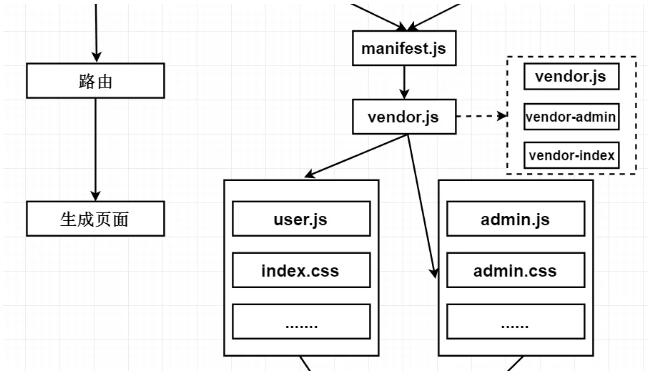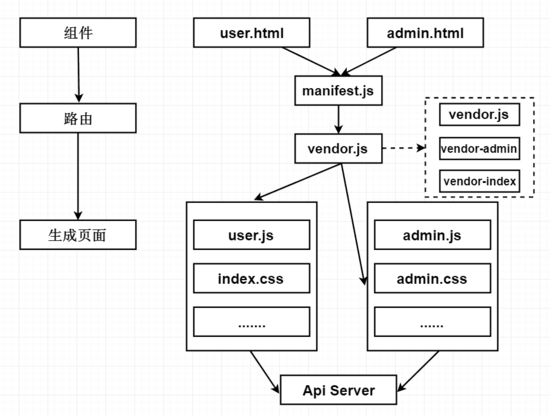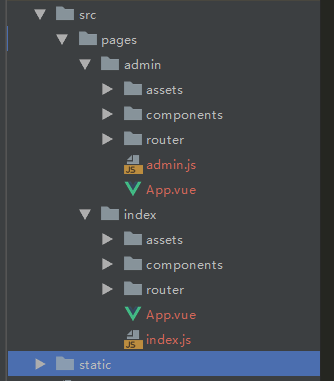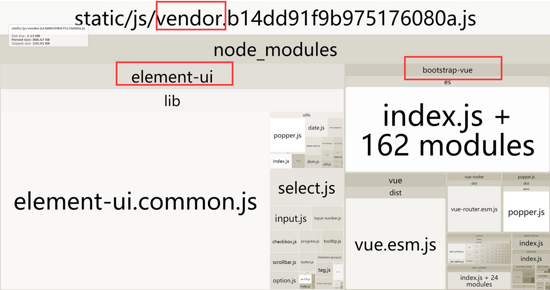vue多页面开发和打包正确处理方法
乘风gg 人气:0
前段时间做项目,技术栈是vue+webpack,主要就是官网首页加后台管理系统 根据当时情况,分析出三种方案
- 一个项目代码里面嵌两个spa应用(官网和后台系统)
- 分开两套项目源码
- 一套项目源码里面就一个spa应用
思考:
- 直接否定了一套项目源码里一个spa应用(ui样式会相互覆盖,如果没有代码规范后期比较难维护)
- 两套源码的话,后台可能开两个端口,然后需要用nginx反向代理可能比较麻烦,而且前端开发也比较麻烦麻烦,毕竟需要维护两个git仓库,两套git上线流程,可能会损耗很多时间。
- 对自己的技术(盲目)自信,也想尝尝鲜,分析出需求也不算很复杂。选了第一种方案,就是多个单页面应用在一套源码里面
上一张多页面的结构图

下载vue spa模板
npm install vue-cli -g vue init webpack multiple-vue-amazing
改造多页面应用
npm install glob --save-dev
修改src文件夹下面的目录结构

在util.js里面加入
/* 这里是添加的部分 ---------------------------- 开始 */
// glob是webpack安装时依赖的一个第三方模块,还模块允许你使用 *等符号, 例如lib/*.js就是获取lib文件夹下的所有js后缀名的文件
var glob = require('glob')
// 页面模板
var HtmlWebpackPlugin = require('html-webpack-plugin')
// 取得相应的页面路径,因为之前的配置,所以是src文件夹下的pages文件夹
var PAGE_PATH = path.resolve(__dirname, '../src/pages')
// 用于做相应的merge处理
var merge = require('webpack-merge')
//多入口配置
// 通过glob模块读取pages文件夹下的所有对应文件夹下的js后缀文件,如果该文件存在
// 那么就作为入口处理
exports.entries = function () {
var entryFiles = glob.sync(PAGE_PATH + '/*/*.js')
var map = {}
entryFiles.forEach((filePath) => {
var filename = filePath.substring(filePath.lastIndexOf('\/') + 1, filePath.lastIndexOf('.'))
map[filename] = filePath
})
return map
}
//多页面输出配置
// 与上面的多页面入口配置相同,读取pages文件夹下的对应的html后缀文件,然后放入数组中
exports.htmlPlugin = function () {
let entryHtml = glob.sync(PAGE_PATH + '/*/*.html')
let arr = []
entryHtml.forEach((filePath) => {
let filename = filePath.substring(filePath.lastIndexOf('\/') + 1, filePath.lastIndexOf('.'))
let conf = {
// 模板来源
template: filePath,
// 文件名称
filename: filename + '.html',
// 页面模板需要加对应的js脚本,如果不加这行则每个页面都会引入所有的js脚本
chunks: ['manifest', 'vendor', filename],
inject: true
}
if (process.env.NODE_ENV === 'production') {
conf = merge(conf, {
minify: {
removeComments: true,
collapseWhitespace: true,
removeAttributeQuotes: true
},
chunksSortMode: 'dependency'
})
}
arr.push(new HtmlWebpackPlugin(conf))
})
return arr
}
/* 这里是添加的部分 ---------------------------- 结束 */
webpack.base.conf.js 文件
/* 修改部分 ---------------- 开始 */
entry: utils.entries(),
/* 修改部分 ---------------- 结束 */
webpack.dev.conf.js 文件
/* 注释这个区域的文件 ------------- 开始 */
// new HtmlWebpackPlugin({
// filename: 'index.html',
// template: 'index.html',
// inject: true
// }),
/* 注释这个区域的文件 ------------- 结束 */
new FriendlyErrorsPlugin()
/* 添加 .concat(utils.htmlPlugin()) ------------------ */
].concat(utils.htmlPlugin())
webpack.prod.conf.js 文件
/* 注释这个区域的内容 ---------------------- 开始 */
// new HtmlWebpackPlugin({
// filename: config.build.index,
// template: 'index.html',
// inject: true,
// minify: {
// removeComments: true,
// collapseWhitespace: true,
// removeAttributeQuotes: true
// // more options:
// // https://github.com/kangax/html-minifier#options-quick-reference
// },
// // necessary to consistently work with multiple chunks via CommonsChunkPlugin
// chunksSortMode: 'dependency'
// }),
/* 注释这个区域的内容 ---------------------- 结束 */
// copy custom static assets
new CopyWebpackPlugin([
{
from: path.resolve(__dirname, '../static'),
to: config.build.assetsSubDirectory,
ignore: ['.*']
}
])
/* 该位置添加 .concat(utils.htmlPlugin()) ------------------- */
].concat(utils.htmlPlugin())
引入第三方ui库
npm install element-ui bootstrap-vue --save
分别在不同的页面引入不同的ui index.js
import BootstrapVue from 'bootstrap-vue' Vue.use(BootstrapVue)
admin.js
import ElementUI from 'element-ui' import 'element-ui/lib/theme-chalk/index.css' Vue.use(ElementUI)
上面多页面的配置是参考网上的,而且网上的思路大都很相似,核心就是改多个entry,配置完成了之后,开发的时候也是发现不了问题的,然后大概就开发了一个月,开发完之后对官网进行性能分析时发现,webpack打包的vendor.js网络加载时间特别长,导致首屏的白屏时间非常长,最终通过-webpack-bundle-analyzer分析得到了结论
npm run build --report

你会发现vendor.js包含了index.html和admin.html的共同部分,所以这个vendor包注定会很大很冗余
解决思路
既然是vendor过大引起加载速度慢,那就分离这个vendor就好了。我是这样想的,把各个页面中都使用到的第三方代码提取至vendor.js中,然后各个页面中用到的第三方代码再打包成各自的vendor-x.js,例如现有页面index.html、admin.html,则最终会打包出vendor.js、vendor-index.js、vendor-admin.js。
webpack.prod.conf.js 文件
new webpack.optimize.CommonsChunkPlugin({
name: 'vendor-admin',
chunks: ['vendor'],
minChunks: function (module, count) {
return (
module.resource &&
/\.js$/.test(module.resource) &&
module.resource.indexOf(path.join(__dirname, '../node_modules')) === 0 &&
module.resource.indexOf('element-ui') != -1
)
}
}),
new webpack.optimize.CommonsChunkPlugin({
name: 'vendor-index',
chunks: ['vendor'],
minChunks: function (module, count) {
return (
module.resource &&
/\.js$/.test(module.resource) &&
module.resource.indexOf(path.join(__dirname, '../node_modules')) === 0 &&
module.resource.indexOf('bootstrap-vue') != -1
)
}
}),
再次分析,一切都很ok,vendor.js被分离成了vendor.js、vendor-index、vendor-admin.js

本来以为解决了CommonsChunkPlugin的分离vendor.js的问题,就可以了,然后打包出来发现index.html和admin.html都少了一个引入(各自对应的那个vendor-xx.js)

解决方案
这个问题其实就是HtmlWebpackPlugin的问题 把原来的 chunksSortMode: 'dependency'改成自定义函数的配置,如下
util.js文件
chunksSortMode: function (chunk1, chunk2) {
var order1 = chunks.indexOf(chunk1.names[0])
var order2 = chunks.indexOf(chunk2.names[0])
return order1 - order2
},
最终实现
- 每个页面加载各自的chunk
- 每个页面有不同的参数
- 每个页面能共享公共chunk
- 浏览器缓存,性能更好
- 如果还嫌慢的话,开启gzip
感想
大功告成了,虽然配置看起来很简单,不过我当时开发的时候,思考了很久,所以假如你CommonsChunkPlugin和HtmlWebpackPlugin不熟悉或者只会用别人第三方的配置表,估计会踩大坑,比如说,CommonsChunkPlugin不指定chunks,默认是什么?minChunks大多数人只会写一个数值,然而自定义一个函数的写法其实才是最强大的,根据我个人的经验chunks结合minChunks自定义函数的写法,能解决几乎所有CommonsChunkPlugin灵异的事件。
总结
以上所述是小编给大家介绍的vue多页面开发和打包正确处理方法,希望对大家有所帮助,如果大家有任何疑问请给我留言,小编会及时回复大家的。在此也非常感谢大家对网站的支持!
加载全部内容